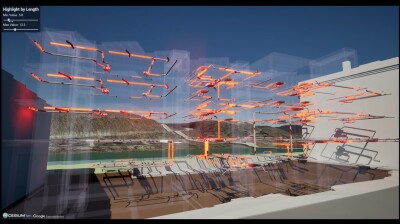The recent acquisition of Cesium by Bently Systems does not come unexpectedly: both companies partnered in the past and worked on 3D spatial technology. However, the focus of each company’s was different; Cesium ion is a foundational open SaaS platform for creating powerful 3D geospatial applications, while Bentley’s iTwin Platform provides the foundation for building SaaS solutions to design, build, and operate infrastructure assets. In hindsight, integrating both platforms into one seemed only a matter of time.
Today, Cesium ion brings 3D geospatial experiences to more than one million active devices every month, while Cesium's open-source offerings have more than 10 million downloads. The combination of Cesium plus Bentley’s iTwin enables developers to seamlessly align 3D geospatial data with digital asset data to create digital twins that scale on many levels.
The importance of visualizing digital twins in a spatial context
Being able to visualize these digital twins in a 3D geospatial context has many benefits for different stakeholders, which explains the reasons behind this acquisition. For example, a 3D geospatial view is an intuitive way for owner-operators and engineering services providers to search for, query, and visualize information about infrastructure networks and assets.
It also enables creating different scenarios of a design, and see the impact on the environment. The combination of 3D digital twins and geospatial 3D environments is now an industry-wide trend: compare this recent acquisition with the Esri and Autodesk partnership from some years ago to bring together CAD and GIS data, workflows, and visualizations.
How this acquisition came to be
In an extensive blog post, Cesium CEO Patrick Cozzi explains how both companies met and started working together on open source projects. He also explains how joining Bentley will accelerate building the open platform that empowers developers to build experiences with 3D geospatial data, and that Cesium remains committed to open source, open standards, and open APIs. He also describes the challenges of open source technology and projects, and how Cesium became a success story despite the many challenges they faced over the years.
Both companies met in 2016, and Bentley quickly saw the potential of Cesium in Infrastructure Engineering, even before Cesium themselves did. Bentley Systems then funded key contributions to open source CesiumJS, an open source JavaScript library for creating world-class 3D globes and maps, and the 3D Tiles specification.
3D tiles open standard
Cesium is the creator of 3D Tiles and continues to support its adoption throughout the ecosystem. Patrick Cozzi lead a team that included Bentley Systems that worked to bring 3D Tiles 1.0 through the OGC Community Standard process, which was adopted as a community standard by the Open Geospatial Consortium (OGC) in 2019. Today, the 3D Tiles open standard has been widely adopted by leading enterprises, governments, and tens of thousands of application developers globally.
Cesium began in 2011, when a team of developers set out to create an application to visualize objects in space. Cesium spun out as an independent company in 2019 and today provides the foundational open platform for an interoperable geospatial ecosystem. Recently, they released a single comprehensive precise 3D dataset of the moon, Cesium Moon Terrain. In April of this year, Cesium announced that their users could now import 3D models from Sketchfab into Cesium ion to create 3D Tiles.






